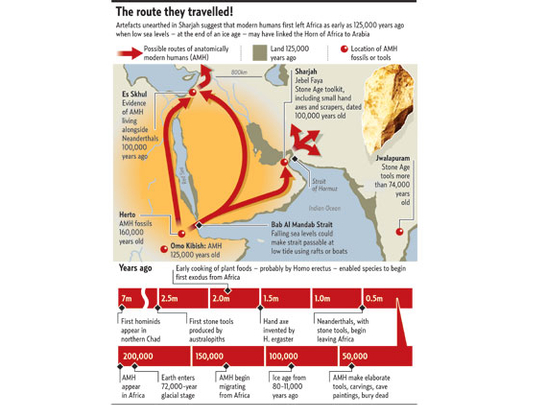
Dubai: Ancient tools unearthed by archeologists at Jebel Faya in Sharjah indicate that humans migrated far out of Africa 125,000 years ago, about 60,000 years earlier than was previously thought.
The evidence from Sharjah is challenging how humans populated the world, giving credence to a theory that the first inhabitants travelled directly from Africa into the Arabian Gulf — and not along the west coast of the Red Sea.
Archeologists recovered hand axes, leaf-shaped blades and other stone tools from a rock shelter on the northeast end of Jebel Faya, a ten-kilometre-long limestone mountain. These tools were made in very different ways from those found in Israel or in North Africa along the Red Sea route.
Primitive tools
The Jeleb Faya stone tools are more primitive and look much more like the tools typical of people living in east and northeast Africa around that time, experts say.
"The exciting thing is that it's a silver dollar's throw from India," John Fleagle, a paleoanthropologist at Stony Brook University in Stony Brook, New York, said. From Sharjah, it is likely that the first humans then spread to the Indian subcontinent and then spread to Europe, Asia and Australia.
Researchers say that water levels 125,000 years ago were much lower. This meant that the Bab Al Mandab Strait, a strip of water separating the horn of Africa from the heel of the Arabian boot, could have been clear for passage at low tide.
The crossing then was just a few kilometres wide, with sea levels 100 metres lower than today. Rather than being hot and dry, the region was a land of lakes and rivers, filled with gazelles, antelope and other grassland animals, allowing safe passage across the Arabian peninsula.
"These ‘anatomically modern' humans — like you and me — had evolved in Africa about 200,000 years ago and subsequently populated the rest of the world," said Simon Armitage of Royal Holloway, University of London.
"Our findings should stimulate a re-evaluation of the means by which we modern humans became a global species," he said.
Preoject leader Hans-Peter Uerpmann, fromt the University of Tubingen in Germany, said that fossilised human bones would be needed "before we can be absolutely sure" that the Jebel Faya tools were made by Homo sapiens. Bones, however, do not survive well in harsh conditions.
The discovery has given fresh impetus for archeologists to scour other potential sites in the UAE. looking for more evidence of passing humans.
Fresh evidence
The new evidence, presented in the journal Science, relies on a range of stone tools excavated at Jebel Faya, which can be dated to 125,000 BC by a technique called optically stimulated luminescence.
According to the conventional view, after reaching the Middle East 70,000 years ago, ancestral modern humans spread fast through Europe and Asia. Neanderthals and other hominids were already living there as the result of earlier migrations out of Africa.
The new evidence would allow Homo sapiens to have made a more leisurely journey through south Asia to Australia, which was populated about 50,000 years ago by ancestors of today's Aboriginals.
Although the Jebel Faya research appears in one of the world's leading peer-review journals, some independent palaeontologists will need more evidence to back up the team's controversial claims.
Mark Beech, of the University of York, who has extensive archaeological experience in the UAE, praised the paper but added: "One site does not confirm the out-of-Africa-via-Arabia hypothesis."
But archeologists will be scouring caves and other potential sites of habitation in the Arabian peninsula for years to come, looking for more evidence of passing human bands.
It is the "first material evidence" that people ventured well out of Africa so long ago, during the Pleistocene, said study coauthor Anthony Marks, a professor emeritus of anthropology with Southern Methodist University who is based in Santa Fe.
— With inputs from Finacial Times and Los Angeles Times








